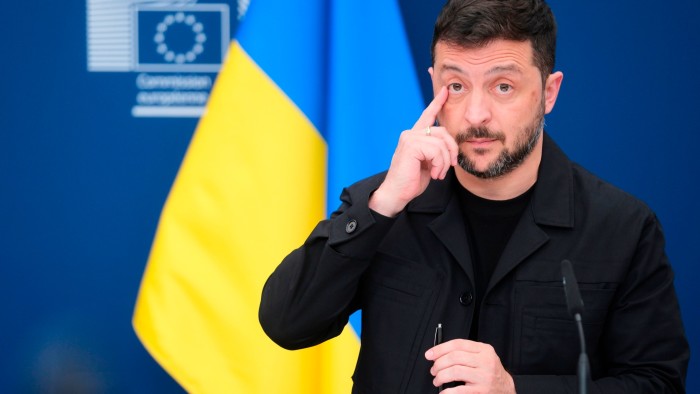Share this @internewscast.com
Volodymyr Zelenskyy is preparing for a pivotal meeting in the Oval Office on Monday, marking one of the most significant engagements of his presidency. This meeting offers him the opportunity to recalibrate ties with Donald Trump, advocate for a fair resolution to the conflict with Russia, and secure assurances for Ukraine’s future security from the US.
Zelenskyy must steer clear of repeating the missteps of his previous White House encounter, during which Vice President JD Vance publicly criticized him and Trump accused Zelenskyy, rather than Vladimir Putin who initiated the comprehensive invasion in 2022, of provoking ‘World War 3’.
Following that incident, the US temporarily halted crucial arms deliveries and intelligence support to Ukraine, casting doubt on Kyiv’s alliance with its primary military ally.
Since then, relations have somewhat mended, although Zelenskyy is unlikely to receive the same level of ceremonious welcome — such as a B2 bomber flyover — that was arranged for Russian President Putin during last week’s summit with Trump in Alaska.
Those images from Anchorage sparked outrage in Kyiv and anxiety that Trump was falling decisively under Putin’s sway.
This time, Zelenskyy will arrive in Washington with reinforcements.
The meeting will include participation from influential leaders such as European Commission President Ursula von der Leyen, German Chancellor Friedrich Merz, UK Prime Minister Sir Keir Starmer, French President Emmanuel Macron, and Nato Secretary-General Mark Rutte.
The focus of their discussions will be to build upon the optimistic developments from the recent brief summit between Putin and Trump, particularly concerning the US’s readiness to ensure Ukraine’s security in the post-war period.
Kostiantyn Yelisieiev, a foreign policy adviser for Zelenskyy’s predecessor Petro Poroshenko, said Monday’s meeting was “about shaping the unified co-ordinated strategy of the collective west towards ending the war in Ukraine and containing aggressive Russia in the long run”.
But the stakes could not be higher for Ukraine and Europe. “The decisions to be taken in Washington on Monday will determine the developments in Europe at least for decades to come,” he said.
Top Trump officials signalled a similar stance on Sunday.
Steve Witkoff, the US special envoy, said on Sunday that Putin had agreed in Alaska to allow Washington and its allies to offer Ukraine security guarantees similar to Nato’s collective defence pledge.
“We were able to win the following concession: that the United States could offer Article 5-like protection, which is one of the real reasons why Ukraine wants to be in Nato,” Witkoff told CNN.

Zelenskyy welcomed US support for security guarantees but said they had to be “very practical, delivering on land, in the air and at sea and must be delivered with Europe’s participation”.
But the issue of territory will be even thornier.
In Alaska, Putin demanded that Ukraine withdraw its forces from the rest of the eastern Donetsk and Luhansk regions in exchange for Russia’s agreement to freeze the frontline.
But Zelenskyy has been clear about his red line: he will not give territory to Putin still under Ukraine’s control.
As crucial as the details is the tone of Monday’s meeting between the US and Ukrainian leaders, whose turbulent history dates back to 2019, when Trump’s request that Kyiv investigate the Biden family led eventually to his impeachment by the US Congress.
A senior Ukrainian official close to the president said Zelenskyy’s goal in the meeting would be to set a “productive peace resolution process without having Ukraine pressed to execute impossible steps, like withdrawing forces” from Donetsk and Luhansk.
For that, the Ukrainian president is ready to make a “digestible compromise” along the current frontline that Ukrainians could accept, the official said.
Yelisieiev said Zelenskyy must “avoid emotions” and even take a page from Putin’s “cold-blooded pragmatism, playing to [the US president’s] interests and goals”.
William Taylor, a former US ambassador to Ukraine, said Zelenskyy would do well to “calmly but directly” tell Trump that Ukraine “will continue to defend itself from Russian aggression”.
“Thank President Trump for supporting a strong security guarantee for Ukraine as part of the coalition of the willing,” he said. “Express hope that the robust US support will continue, but make it clear that Ukraine will continue to defend itself. It has no other choice.”
Several US and Ukrainian current and former officials are more pessimistic about the Monday meeting, fearing Zelenskyy may struggle to change the dynamic in Kyiv’s favour.
Ivanna Klympush-Tsintsadze, an opposition MP in Ukraine, said she did not believe the terms being discussed could “actually lead to lasting and sustainable peace, not to mention a just peace”.
Yulia Klymenko, another opposition lawmaker, said she feared Trump’s wrath if Zelenskyy was too rigid or pushed back too strongly.
Ukraine would then “probably be back to square one with Trump threatening to withdraw intelligence support and the Europeans trying to change his mind back again”.
To prevent the US president from selling out Ukraine, officials said Zelenskyy should appeal to Trump’s peacemaking ambitions.
He could also argue that without US security guarantees — and without keeping hold of remaining Ukrainian fortified positions in Donetsk and Luhansk — Putin could invade again, imperilling the US-Ukraine mineral deal signed in April.
Many of Ukraine’s critical minerals lie under the rich soil of those eastern regions.
Volodymyr Fesenko, a Kyiv-based political analyst, said the meeting was the “beginning of a tactical fight” to win over Trump. “Putin is pulling him to his side, and European leaders as well as Zelenskyy are trying to get him back on the side of a fair peace.”
The best outcome, said Yelisieiev, could be a “swift decision” on Trump’s part “to increase pressure on Putin and his allies through sanctions from hell”.
“Enforcing peace on Putin is the best-case scenario. The worst scenario is an ultimatum by Trump to Zelenskyy and European leaders to sign under the Alaska arrangements [with Putin] or go fighting without further US support.”
Also key for Ukraine is to resist the land grab for the rest of Donetsk and Luhansk that Putin presented to Trump in Alaska — Zelenskyy’s red line.
The prospect of Kyiv being forced to cede to Moscow parts of eastern Ukraine that the Russian army has failed to capture since its first invasion in 2014 is widely seen as unacceptable in Ukraine.
“No matter what Putin says, the Ukrainian army will not retreat without a fight from a single square kilometre,” said Denys Yaroslavskiy, a serviceman and head of an intelligence unit in the 57th brigade.
But Russia’s army continues to push deeper into Ukraine.
For the third straight month, they have advanced at their fastest pace in a year along most of the 1,300km front line, and last week pushed 10km closer to the coal-mining town of Dobropillia. Ukrainian military command deployed experienced units to contain the breach and the general staff said on Sunday that it had stabilised the situation.

Putin has said that his forces will continue their attacks even as peace talks take place, meaning time is of the essence.
Standing alongside von der Leyen, the commission president, on Sunday, Zelenskyy called for “real negotiations” that he said should begin at the current frontline.
“We are working out a common vision of what a peace agreement should be,” he added. “Fair, swift and effective.”
But Klympush-Tsintsadze warned that any settlement must not reward Russia for its aggression, saying that “feeding Russian ambitions” would only increase its appetite for more conquest.
“It will create the conditions for another Russian attack,” she said.
A senior Ukrainian security official said that was the reason why any deal must be worth the paper it is printed on.
“Treaties only work when underpinned by real power” like that of Nato, the official said. “And relations with Russia are about power.”











